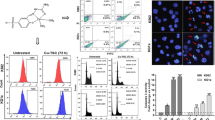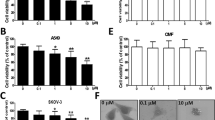Abstract
Understanding the mechanisms involved in apoptosis has been an area of extensive study due to its critical role in the development and homeostasis of multi-cellular organisms. Our special interest lies in understanding the apoptosis of tumor cells which is mediated by novel potential drugs. Cephalostatin 1 is a marine compound that can induce apoptosis in leukemic cells in a dose- and time-dependent manner even at nano-molar concentrations using a recently discovered pathway that excludes the receptor-mediated pathway and which includes both the mitochondrial and endoplasmic reticulum pathways (Dirsch et al., Cancer Res 63:8869–8876, 2003; López-Antón et al., J Biol Chem 28:33078–33086, 2006). In this paper, the methods and tools of Petri net theory are used to construct, analyze, and validate a discrete Petri net model for cephalostatin 1-induced apoptosis. Based on experimental results and literature search, we constructed a discrete Petri net consisting of 43 places and 59 transitions. Standard Petri net analysis techniques such as structural and invariant analyses and a recently developed modularity analysis technique using maximal abstract dependent transition sets (ADT sets) were employed. Results of these analyses revealed model consistency with known biological behavior. The sub-modules represented by the ADT sets were compared with the functional modules of apoptosis identified by Alberghina and Colangelo (BMC Neurosci 7(Suppl 1):S2, 2006).








Similar content being viewed by others
References
Albeck JG, Murke JM, Aldridge BB et al (2008) Quantitative analysis of pathways controlling extrinsic apoptosis in single cells. Mol Cell 30:11–25
Alberghina L, Colangelo AM (2006) The modular systems biology approach to investigate the control of apoptosis in Alzheimer’s disease neurodegeneration. BMC Neurosci 7(Suppl 1):S2
Bagci EZ, Vodovotz Y, Billiar TR et al (2006) Bistability in apoptosis: roles of Bax, Bcl-2, and mitchondrial permeability transition pores. Biophys J 90:1546–1559
Bentele M, Lavrik I, Ulrich M et al (2004) Mathematical modeling reveals threshold mechanism in CD95-induced apoptosis. J Cell Biol 166:839–851
Chaouiya C (2007) Petri net modeling of biological networks. Brief Bioinform 8(4):210–219
Dirsch VM, Müller IM, Eichhorst ST et al (2003) Cephalostatin 1 selectively triggers the release of Smac/Diablo and subsequent apoptosis that is characterized by an increased density of the mitochondrial matrix. Cancer Res 63:8869–8876
Eissing T, Conzelmann H, Gilles ED et al (2004) Bistability analyses of a caspase activation model for receptor-induced apoptosis. J Biol Chem 279:36892–36897
Fussenegger M, Bailey J, Varner J (2000) A mathematical model of caspase function in apoptosis. Nat Biotechnol 18:768–774
Heiner M (2009) Understanding network behavior by structured representations of transition invariants—a petri net perspective on systems and synthetic biology. In: Condon A et al (eds) Algorithmic bioprocesses. Springer, Natural Computing Series, Berlin
Heiner M, Koch I (2004) Petri net based system validation in systems biology. In: Proc. ICATPN. Bologna, Springer, LNCS 3099, pp 216–237
Heiner M, Koch I, Will J (2004) Model validation of biological pathways using petri nets—demonstrated for apoptosis. BioSystems 75:15–28
Hua F, Cornejo MG, Cardone et al (2005) Effects of Bcl-2 levels on Fas signaling-induced caspase-3 activation: molecular genetic tests of computational model predictions. J Immunol 175:987–995
Ishii H, Suzuki Y, Kuboki M et al (1992) Activation of clapain 1 in thrombin-stimulated platelets is regulated by the initial elevation of the cytosolic Ca2+ concentration. Biochem J 284:755–760
Koch I, Heiner M (2008) Petri nets. In: Junker B, Schreiber F (eds) Biological network analysis. Wiley Book Series on Bioinformatics (Chapter 7). New Jersey
Koch I, Junker BH, Heiner M (2005) Application of Petri net theory for modeling and validation of the sucrose breakdown pathway in the potato tuber. Bioinformatics 21:1219–1226
Legewie S, Blüthgen N, Herzel H (2006) Mathematical modeling identifies inhibitors of apoptosis as mediators of positive feedback and bistability. PLoS Comput Biol 2(9):e120
Li C, Ge QW, Nakata M et al (2007) Modelling and simulation of signal transductions in an apoptosis pathway by using timed Petri nets. J Biosci 32(1):113–127
López-Antón N, Rudy A, Barth N et al (2006) The marine product cephalostatin 1 activates an ER stress-specific and apoptosome-independent apoptotic signaling pathway. J Biol Chem 28:33078–33086
Mandic A, Viktorsson K et al (2002) Calpain-mediated bid cleavage and calpain-independent Bak modulation: two separate pathways in cisplatin-induced apoptosis. Mol Cell Biol 22:3003–3013
Matsuno H, Tanaka Y, Aoshima H et al (2003) Biopathways representation and simulation on hybrid functional Petri net. In Silico Biol 3:0032
Müller IM, Dirsch VM, Rudy A et al (2005) Cephalostatin 1 inactivates Bcl-2 by hyperphosphorylation independent of M-phase arrest and DNA damage. Mol Pharmacol 67:1684–1689
Nakagawa T, Yuan J (2000) Cross-talk between two cysteine protease families: activation of caspase 12 by calpain in apoptosis. J Cell Biol 4:887–894
Nijhawan D, Honarpour N, Wang X (2000) Apoptosis in neural development and disease. Annu Rev Neurosci 23:73–87
Penney J, Westhead D, MocConkey G (2003) Petri net representations in systems biology. Biochem Soc Trans 3:1513–1515
Reddy VN, Liebman MN, Mavrovouniotis ML (1996) Qualitative analysis of biochemical reaction systems. Comput Biol Med 26:9–24
Rehm M, Huber HJ, Düssmann H et al (2006) Systems analysis of effector caspase activation and its control by X-linked inhibitor of apoptosis protein. EMBO J 25:4338–4349
Rizzuto R, Pinton P, Ferrari D et al (2003) Calcium and apoptosis: facts and hypotheses. Oncogene 22:8619–8627
Rudy A, Lopez-Anton N, Dirsch VM, Vollmar A (2008a) The cephalostatin way of apoptosis. J Nat Prod 71:482–486
Rudy A, Lopez-Anton N, Barth N et al (2008b) Role of Smac in cephalostatin-induced cell death. Cell Death Differ 15:1930–1940
Szegedzdi E, Logue S, Gorman A et al (2006) Mediators of endoplasmic reticulum stress-induced apoptosis. EMBO Reports 7(9):880–885
Tinel A, Tschopp J (2004) The PIDDosome, a protein implicated in activation of caspase-2 in response to genotoxic stress. Science 304:843–846
Yap R (2006) Modeling the receptor-mediated pathway using hybrid Petri nets. Thesis, College of Science, University of the Philippines
Author information
Authors and Affiliations
Corresponding author
Electronic supplementary material
Below is the link to the electronic supplementary material.
Rights and permissions
About this article
Cite this article
Rodriguez, E.M., Rudy, A., del Rosario, R.C.H. et al. A discrete Petri net model for cephalostatin-induced apoptosis in leukemic cells. Nat Comput 10, 993–1015 (2011). https://doi.org/10.1007/s11047-009-9153-9
Received:
Accepted:
Published:
Issue Date:
DOI: https://doi.org/10.1007/s11047-009-9153-9




